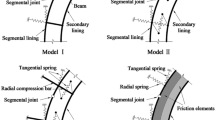Abstract
To investigate the mechanical responses of secondary lining of high-speed railway tunnel, two numerical models for simulating Reinforced Concrete Secondary Lining (RCSL) and Plain Concrete Secondary Lining (PCSL) are built respectively based on the principle of soil-structure interaction. The simulations are performed under different values of coefficient of lateral pressure (λ). The numerical results indicate that the embedded reinforcement enhances the strength of secondary lining. The coefficient of lateral pressure has significant influence on the secondary lining strength.
Similar content being viewed by others
References
Duddeck, H. and Erdmann, J. (1985). “On structure design models for tunnels in soft soil.” Underground Space, vol. 9, Nos. 5–6, pp. 246–259.
Jankowiak, T. and Lodygowski, T. (2005). “Identification of parameters of concrete damage plasticity constitutive model.” Foundations of Civil and Environmental Engineering, vol. 6, no. 1, pp. 53–69.
Lee, J. and Fenves, G. L. (1998a). “A plastic-damage concrete model for earthquake analysis of dams.” Earthquake Engineering and Structural Dynamics, vol. 27, no. 9, pp. 937–956, DOI: 10.1002/(SICI)1096-9845(199809)27:9%3C937::AID-EQE764%3E3.0.CO;2-5.
Lee, J. and Fenves, G. L. (1998b). “Plastic-damage model for cyclic loading of concrete structures.” Journal of Engineering Mechanics, vol. 124, no. 8, pp. 892–900, DOI: 10.1061/(ASCE)0733-9399 (1998)124:8(892).
Lubliner, J., Oliver, S., Oller, E., and Onate, A. (1989). “Plastic-damage model for concrete.” International Journal of Solids and Structures, vol. 25, no. 3, pp. 229–326, DOI: 10.1016/0020-7683(89)90050-4.
Oreste, P. P. (2007). “A numerical approach to the hyperstatic reaction method for the dimensioning of tunnel supports.” Tunnelling and Underground Space Technology, vol. 22, no. 2, pp. 185–205, DOI: 10.1016/j.tust.2006.05.002.
Rabcewicz, L. (1964a). “The new Austrian tunnelling method. Part I.” Water Power, vol. 16, no. 11, pp. 453–457.
Rabcewicz, L. (1964b). “The new Austrian tunnelling method. Part II.” Water Power, vol. 16, no. 12, pp. 511–515.
Rabcewicz, L. (1965). “The new Austrian tunnelling method. Part III.” Water Power, vol. 17, no. 1, pp. 19–24.
TB10003−2005 (2005). Code for design on tunnel of Railway, The Professional Standards Compilation Group of People’s Republic of China, Beijing, China. (in Chinese)
Author information
Authors and Affiliations
Corresponding author
Rights and permissions
About this article
Cite this article
Zhang, N., Fang, Q., Li, Y. et al. Mechanical Analysis of Secondary Lining of High-Speed Railway Tunnel. KSCE J Civ Eng 22, 2384–2389 (2018). https://doi.org/10.1007/s12205-017-1524-7
Received:
Revised:
Accepted:
Published:
Issue Date:
DOI: https://doi.org/10.1007/s12205-017-1524-7




